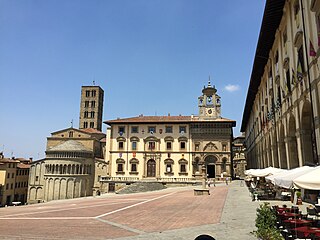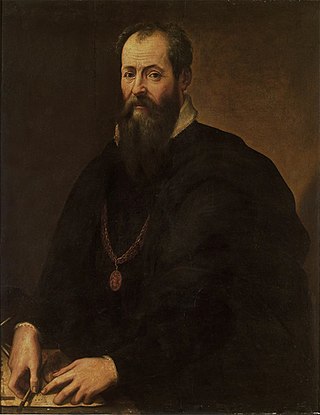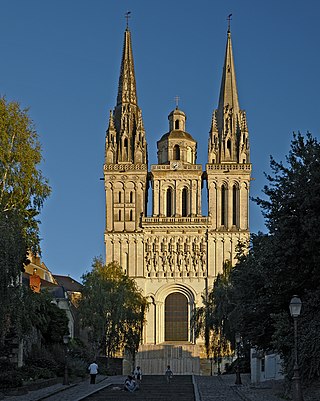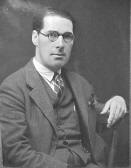

Guillaume de Marcillat (ca. 1470–1529) was a French painter and stained glass artist.


Guillaume de Marcillat (ca. 1470–1529) was a French painter and stained glass artist.
He was born in La Châtre, Indre about 1470. He was in Rome by 1509, where he was employed by the popes Julius II and Leo X in the Vatican and at Santa Maria del Popolo, where the two windows in the choir are his earliest surviving works. In 1515, he was summoned by Cardinal Silvio Passerini to Cortona, where he established a workshop, that produced stained glass windows for the Madonna del Calcinaio Cathedral. By 1519 he was in Arezzo, where he produced windows for the Cathedral of Arezzo and the Basilica of San Francesco. He also painted biblical frescos in the vault of the Cathedral of Arezzo.
He died in Arezzo, Italy in 1529.

Arezzo is a city and comune in Italy and the capital of the province of the same name located in Tuscany. Arezzo is about 80 kilometres southeast of Florence at an elevation of 296 metres (971 ft) above sea level. As of 2022, the population was about 97,000.

Giorgio Vasari was an Italian Renaissance painter and architect, who is best known for his work The Lives of the Most Excellent Painters, Sculptors, and Architects, considered the ideological foundation of all art-historical writing, and still much cited in modern biographies of the many Italian Renaissance artists he covers, including Leonardo da Vinci and Michelangelo, although he is now regarded as including many factual errors, especially when covering artists from before he was born.

Stained glass is coloured glass as a material or works created from it. Throughout its thousand-year history, the term has been applied almost exclusively to the windows of churches and other significant religious buildings. Although traditionally made in flat panels and used as windows, the creations of modern stained glass artists also include three-dimensional structures and sculpture. Modern vernacular usage has often extended the term "stained glass" to include domestic lead light and objets d'art created from foil glasswork exemplified in the famous lamps of Louis Comfort Tiffany.

The Cathedral of St. Michael and St. Gudula, usually shortened to the Cathedral of St. Gudula or St. Gudula by locals, is a medieval Roman Catholic cathedral in central Brussels, Belgium. It is dedicated to Saint Michael and Saint Gudula, the patron saints of the City of Brussels, and is considered to be one of the finest examples of Brabantine Gothic architecture.

Francesco del Cossa was an Italian Renaissance painter of the School of Ferrara, who after 1470 worked in Bologna. Cossa is best known for his frescoes, especially his collaboration with Cosimo Tura on a cycle of the months in the Palazzo Schifanoia of the Este family, rulers of Ferrara. Otherwise, his paintings are mostly of religious subjects, with some portraits and drawings attributed to him. He also designed stained glass.

Rouen Cathedral is a Catholic church in Rouen, Normandy, France. It is the see of the Archbishop of Rouen, Primate of Normandy. It is famous for its three towers, each in a different style. The cathedral, built and rebuilt over a period of more than eight hundred years, has features from Early Gothic to late Flamboyant and Renaissance architecture. It also has a place in art history as the subject of a series of impressionist paintings by Claude Monet.

Bourges Cathedral is a Roman Catholic church located in Bourges, France. The cathedral is dedicated to Saint Stephen and is the seat of the Archbishop of Bourges. Built atop an earlier Romanesque church from 1195 until 1230, it is largely in the Classic Gothic architectural style and was constructed at about the same time as Chartres Cathedral. The cathedral is particularly known for the great size and unity of its interior, the sculptural decoration of its portals, and the large collection of 13th century stained glass windows. Owing to its quintessential Gothic architecture, the cathedral was declared a UNESCO World Heritage Site in 1992.

Le Mans Cathedral is a Catholic church situated in Le Mans, France. The cathedral is dedicated to Saint Julian of Le Mans, the city's first bishop, who established Christianity in the area around the beginning of the 4th century. Its construction dated from the 6th through the 1thth century, culminating in 1430 and it features many French Gothic elements.

Angers Cathedral is a Catholic church dedicated to Saint Maurice in Angers, France. It is the seat of the Bishops of Angers.

Cahors Cathedral is a Roman Catholic church located in the town of Cahors, Occitanie, France. A national monument, it is an example of the transition between the late Romanesque and Gothic architectural traditions.
Guglielmo da Marsiglia (1475–1537) was an Italian painter of stained glass of the 16th century. He is also known as Guglielmo da Marcillat and was a native of Dt. Michiel near Meuse, France.

William Warrington, (1796–1869), was an English maker of stained glass windows. His firm, operating from 1832 to 1875, was one of the earliest of the English Medieval revival and served clients such as Norwich and Peterborough Cathedrals. Warrington was an historian of medieval glass and published an illustrated book The History of Stained Glass.
The firm of James Powell and Sons, also known as Whitefriars Glass, were London-based English glassmakers, leadlighters and stained-glass window manufacturers. As Whitefriars Glass, the company existed from the 17th century, but became well known as a result of the 19th-century Gothic Revival and the demand for stained glass windows.
Events from the year 1529 in art.
The decade of the 1470s in art involved some significant events.

Arezzo Cathedral is a Roman Catholic cathedral in the city of Arezzo in Tuscany, Italy. It is located on the site of a pre-existing Palaeo-Christian church and, perhaps, of the ancient city's acropolis.

Glass art refers to individual works of art that are substantially or wholly made of glass. It ranges in size from monumental works and installation pieces to wall hangings and windows, to works of art made in studios and factories, including glass jewelry and tableware.

James Humphries Hogan RDI FSGT FRS was an English stained glass designer with the firm of James Powell and Sons throughout his career, rising from apprentice to be managing director of the company. He made magnificent stained glass for many of England's cathedrals, including the 100 feet high central windows of Liverpool Cathedral.
Events from the year 1470 in France
Pierre Spicre was a painter in the Duchy of Burgundy.